For most people, owls remain a mystery because of their nighttime habits. Even the most ardent birdwatchers will have a difficult time spotting them because they are so well disguised and silent. It’s interesting to note that, like human newborns, baby owls sleep with their heads resting on the branch or structure they’re lying on. This is due to the fact that owlets’ heads are quite heavy, and they haven’t yet developed strong neck muscles to support them as they sleep. When a newborn owl grows up and develops stronger neck muscles, it may often sleep upright with its head pointing forward or even backward.
How Much Sleep Do Owls Need?
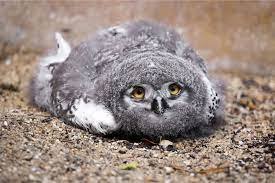
Owls, like all birds, require a minimum of 12 hours of sleep per day. There is a possibility that they, unlike humans, do not sleep for a full 12 hours every day. Owls are known to take a series of brief snoozes throughout the day to refuel.
In general, owls are still aware of their surroundings as they sleep. The reason for this is that they need to know whether there are any predators lurking around. In order to keep one eye open while the other is closed, owls have to sleep with one eye open and the other closed.
Also, know Do owls hibernate?
Owls’ sleeping habits
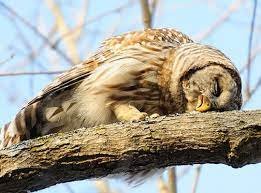
By closing their eyes, owls can fall asleep perched on a limb in an upright position. Before dozing off, they’ll secure a strong grip on a branch with their talons. To open their back toes, known as the hallux, they must bend or extend their legs.
Many birds sleep with their beak and face tucked behind their back feathers while they slumber. Owls, on the other hand, are unable to accomplish this because of their unique neck structure and instead close their eyes. The majority of owls sleep with their heads facing forward, however, this is not always the case.
Why don’t baby owls fall from the trees while sleeping?
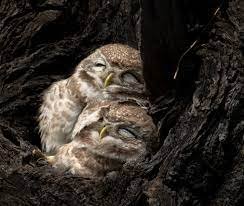
Most of the time, the rear of a newborn owl’s foot has a special claw that hooks on and doesn’t let go as they sleep, making it difficult for them to tumble out of their nest. This is known as the hallux. It is able to hold onto trees and ledges to protect the young owls. Babies of owls are born blind and helpless, therefore their mother stays by the nest to protect them. It is up to the father owl to hunt for food and provide it to the mother, who will feed the young.
Is it normal for owls to sleep on their backs?
Yes, these nocturnal animals do indeed sleep on their backs. For this reason, they sleep differently from other birds and mammals since their heads are larger and heavier in relation to their body weight.
Sleeping habits of adult owls
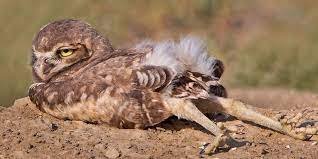
Adult owls rest their heads on their paws when they sleep. They may occasionally lean their heads forward or back. A hollow tree or crevice is a common place for them to hide out. This is a safe place for Great Horned owls to rest, as they are protected from predators by the tree’s greenery and the darkness it generates. During this time, they close their eyes and drift off to dreamland.
Sleeping habits of the Owlet
In contrast to adult owls, their owlets prefer to sleep on their backs, which allows them to obtain a good night’s slumber. Baby owls have enormous facial discs, just like their full-grown counterparts. Unfortunately, they lack the muscle to retain their enormous heads in an upright position when they are sleeping.
In order to get some shut-eye, these nocturnal infant critters have to keep their heads down as they sleep. Owls’ resting positions startle some people; they think the birds are dead. The fact that they don’t fall off trees even after lying down entirely is another interesting tidbit to discuss.
When do owls go to bed?
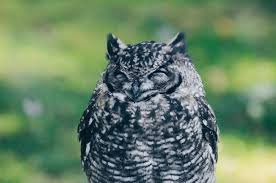
During the daytime, owls doze off. Due to their nature as nocturnal predators, they only go out to prey at night. They get between 10 and 12 hours of sleep each night. Roosting in a tree branch high in the treetops is a preferred location for them. The rodents, lizards, and frogs they prey on are all nocturnal. With their superb hearing and eyesight, owls are able to look for and catch prey at night.
Is it common for owls to sleep on their bellies?
Unlike owlets, which are known to sleep on their stomachs, adult owls do not doze on their stomachs. Owls are nighttime predators. It is common knowledge that owls prefer to sleep sitting up. Owls and eagles are both raptors, hence they are often compared to each other. With their strong talons, they aim right at their prey. It’s well-documented that these two animals’ sleeping habits are quite similar. Babies of owls sleep on their stomachs because of their heavy faces, which causes the adults to sleep in an upright position. According to Rees, baby owls sleep on their backs, with their heads tucked under their wings.

Due to the lack of ear tufts on an owl’s face, their sleeping habits are very different from other birds. Baby owls sleep with their backs to the side and their stomachs flat on the ground. When compared to adult owls, young or baby owls are regarded to be feeble. Baby owls can’t hold their heads up, so they spend most of their time sleeping or napping on tree limbs.
Final Thoughts
Owls prefer to sit on a tree branch, either upright or snuggled in a tree’s hollow, to rest their heads. Due to their small size, owlets are unable to sleep upright like this and instead prefer to sleep on their stomachs, with their heads turned to the side. Even while the majority of owl species spend the day sleeping, there are a few that you may witness hunting for food during daylight hours.





